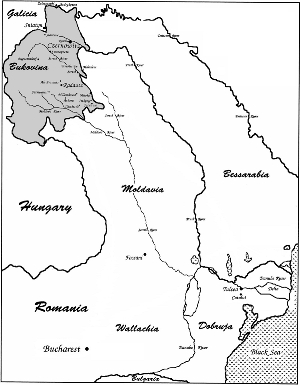Bukovina
An alternate spelling is Bukowina.
The term "Bukovina-German" refers to the German, Bohemian, and Zipser emigrants who settled in Bukovina, a southeastern region of Austria-Hugary about two hundred years ago. After a century of farming in Bukovina, many people left to find new land and new opportunities in the United States and Canada.
|
Note: you will see that the present day names are variations on the old names. |
I hope with these pages to help preserve the heritage and history of these people. This is more than genealogy, what a person is and who they are, is his or her history. It is important to know who the Bukovina-Germans were and where they are today. What were their lives like? What was the reason behind their emigration from Germany to Bukovina? and why some 100 years later did they emigrate again, this time into the United States and Canada?
German Roots
Where did these Bukovina-Germans come from and why? To answer this it is important to know a little about the land called Bukovina. Bukovina lies on the outer eastern curve of the Carpathian mountains in southeastern Europe. It's recorded history starts in the 13th century with the disintegration of the Cuman Tartar Empire. The area became an important border of Moldavia around the year 1514. By the year 1775 it had been annexed by Austria and was used as a land bridge linking Transylvania and Galicia. Originally the area was known as "Austrian Moldavia. The name Bukovina can be credited to General Karl Baron von Enzenberg, 2nd military governor of the area. He renamed the land "Bukovina" which is Polish, Buko_v_ina means land of the beech (trees) Buk is beech (tree); -vina is a suffix meaning land of.
Austria's empress, Maria Theresa, then began to recruit german colonists whom she expected to facilitate economic development and to aid in defending the area from any external aggressors. German farmers were invited by her to settle in Bukovina. In 1780 the Patent of Toleration and in 1782 the Patent of Settlement, promised to eligible immigrants benefits such as free transportation, a house with garden, fields and animals. Also, exemption from taxation for the first 10 years of residency, exemption from military service for the eldest son of the family and complete freedom of conscience and religion. Immigrants came from many different parts of Germany. Three regions have been identified, 1) southwestern Germany, which includes the Swabian regions of the Palatinate and Wurttemberg as well as the Rhineland; 2) German Bohemia; 3) the Zips district in upper Hungary, which is now identified as Spis in Slovakia.
After arriving in Bukovina the Germans were directed to "Fratautz", this is were they received directions to the already existing Romanian or Ukrainian communities in which they were to live. The farmers were given about 12 hectares of farm ground, a wooden home with outbuildings, livestock, farm implements, and advances on seed grain.
The Tosczak and Deutscher families came from Radautz (Radauti) in Bukovina.
